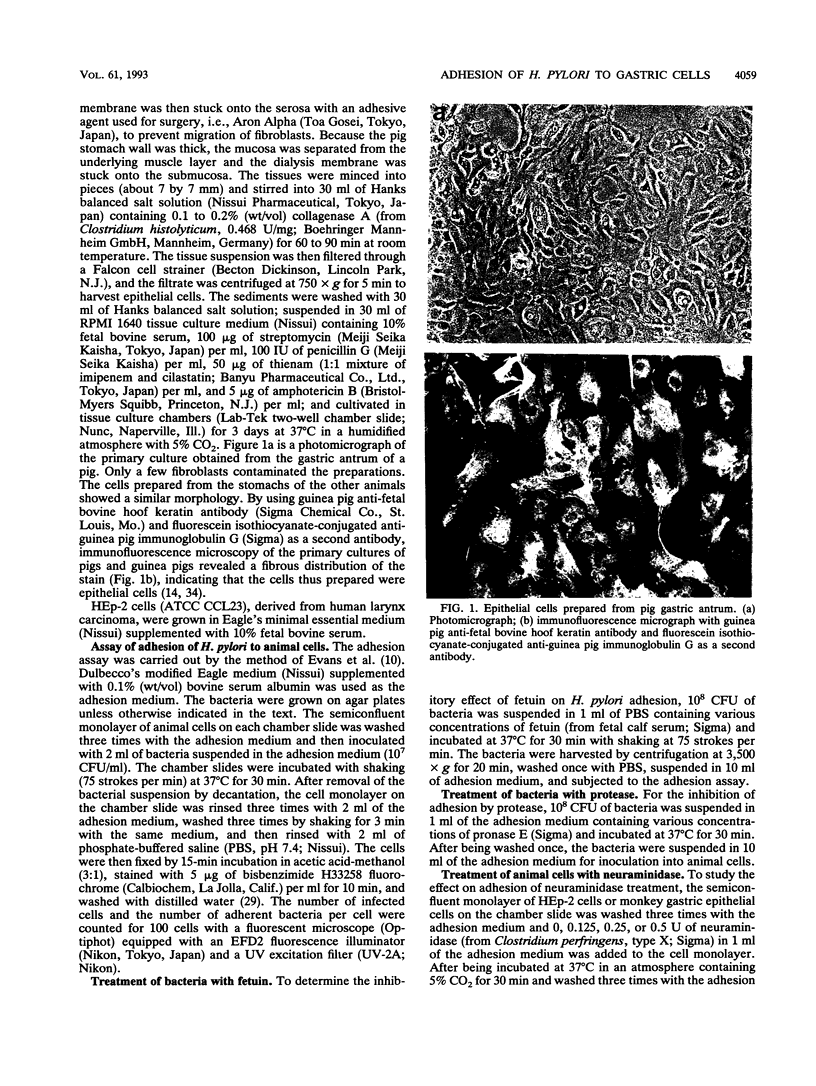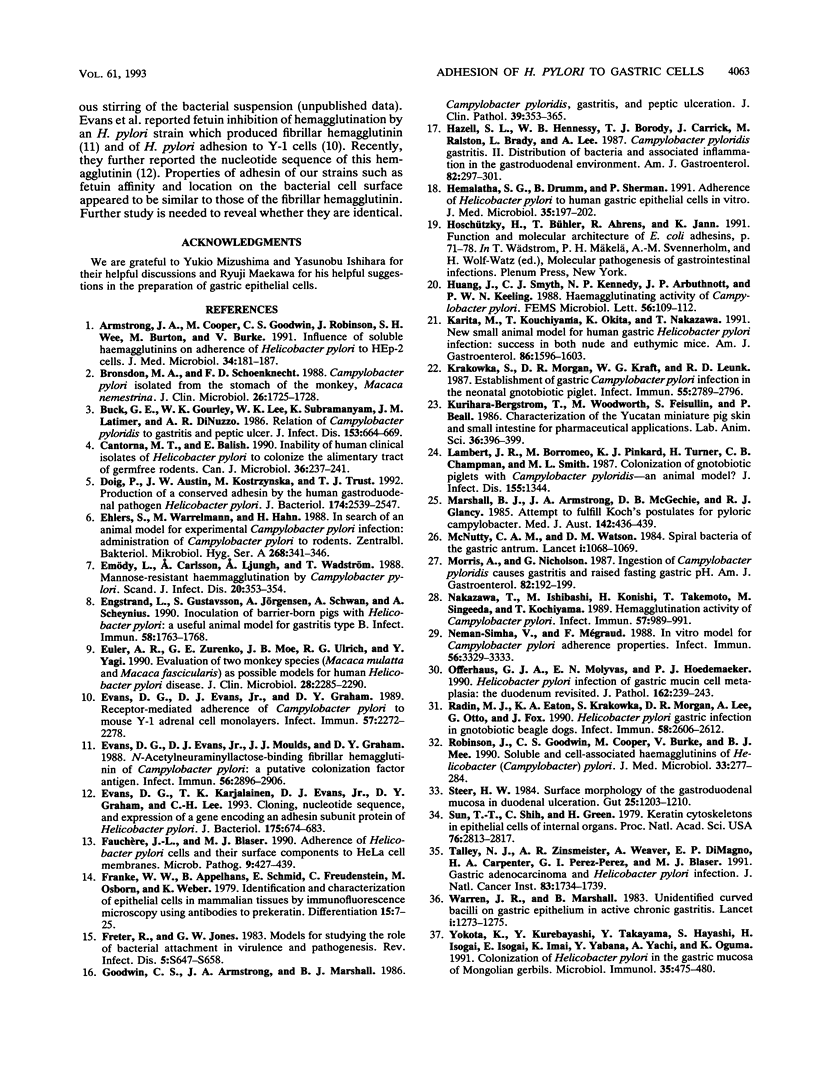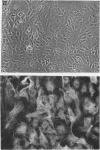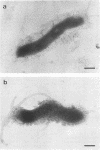Abstract
Of 35 strains of Helicobacter pylori tested, 5 were found to adhere well to HEp-2 cells. We selected three of these adhesive strains and four from the remaining strains to examine their ability to adhere to gastric epithelial cells in primary cultures obtained by collagenase digestion of stomachs from mice, rats, Mongolian gerbils, guinea pigs, pigs, and cynomolgus monkeys. The three adhesive strains adhered well to epithelial cells from monkey and pig gastric antra. The adhesion was inhibited by incubating the bacterial cells with fetuin, and this inhibition was further confirmed by the binding of gold-labeled fetuin to the surface of the adhesive strains. However, these adhesive strains only weakly adhered to fundic epithelial cells from monkeys and pigs and to gastric epithelial cells from the other animals. As for the four strains poorly adhesive to HEp-2 cells, they adhered weakly to gastric epithelial cells from all of the animals tested. They had higher hemagglutination titers than the adhesive strains, showing that there was no correlation between hemagglutination titers and the ability to adhere to gastric cells. Taking the similarities of human and monkey or pig stomachs into consideration, these results suggest that the primary target cell of H. pylori in colonization in human stomachs is the antral epithelial cell and that the putative adhesin involved in adhesion has affinity for fetuin.
Full text
PDF





Images in this article
Selected References
These references are in PubMed. This may not be the complete list of references from this article.
- Armstrong J. A., Cooper M., Goodwin C. S., Robinson J., Wee S. H., Burton M., Burke V. Influence of soluble haemagglutinins on adherence of Helicobacter pylori to HEp-2 cells. J Med Microbiol. 1991 Mar;34(3):181–187. doi: 10.1099/00222615-34-3-181. [DOI] [PubMed] [Google Scholar]
- Bronsdon M. A., Schoenknecht F. D. Campylobacter pylori isolated from the stomach of the monkey, Macaca nemestrina. J Clin Microbiol. 1988 Sep;26(9):1725–1728. doi: 10.1128/jcm.26.9.1725-1728.1988. [DOI] [PMC free article] [PubMed] [Google Scholar]
- Buck G. E., Gourley W. K., Lee W. K., Subramanyam K., Latimer J. M., DiNuzzo A. R. Relation of Campylobacter pyloridis to gastritis and peptic ulcer. J Infect Dis. 1986 Apr;153(4):664–669. doi: 10.1093/infdis/153.4.664. [DOI] [PubMed] [Google Scholar]
- Cantorna M. T., Balish E. Inability of human clinical strains of Helicobacter pylori to colonize the alimentary tract of germfree rodents. Can J Microbiol. 1990 Apr;36(4):237–241. doi: 10.1139/m90-041. [DOI] [PubMed] [Google Scholar]
- Doig P., Austin J. W., Kostrzynska M., Trust T. J. Production of a conserved adhesin by the human gastroduodenal pathogen Helicobacter pylori. J Bacteriol. 1992 Apr;174(8):2539–2547. doi: 10.1128/jb.174.8.2539-2547.1992. [DOI] [PMC free article] [PubMed] [Google Scholar]
- Ehlers S., Warrelmann M., Hahn H. In search of an animal model for experimental Campylobacter pylori infection: administration of Campylobacter pylori to rodents. Zentralbl Bakteriol Mikrobiol Hyg A. 1988 May;268(3):341–346. doi: 10.1016/s0176-6724(88)80018-x. [DOI] [PubMed] [Google Scholar]
- Emödy L., Carlsson A., Ljungh A., Wadström T. Mannose-resistant haemagglutination by Campylobacter pylori. Scand J Infect Dis. 1988;20(3):353–354. doi: 10.3109/00365548809032466. [DOI] [PubMed] [Google Scholar]
- Engstrand L., Gustavsson S., Jörgensen A., Schwan A., Scheynius A. Inoculation of barrier-born pigs with Helicobacter pylori: a useful animal model for gastritis type B. Infect Immun. 1990 Jun;58(6):1763–1768. doi: 10.1128/iai.58.6.1763-1768.1990. [DOI] [PMC free article] [PubMed] [Google Scholar]
- Euler A. R., Zurenko G. E., Moe J. B., Ulrich R. G., Yagi Y. Evaluation of two monkey species (Macaca mulatta and Macaca fascicularis) as possible models for human Helicobacter pylori disease. J Clin Microbiol. 1990 Oct;28(10):2285–2290. doi: 10.1128/jcm.28.10.2285-2290.1990. [DOI] [PMC free article] [PubMed] [Google Scholar]
- Evans D. G., Evans D. J., Jr, Graham D. Y. Receptor-mediated adherence of Campylobacter pylori to mouse Y-1 adrenal cell monolayers. Infect Immun. 1989 Aug;57(8):2272–2278. doi: 10.1128/iai.57.8.2272-2278.1989. [DOI] [PMC free article] [PubMed] [Google Scholar]
- Evans D. G., Evans D. J., Jr, Moulds J. J., Graham D. Y. N-acetylneuraminyllactose-binding fibrillar hemagglutinin of Campylobacter pylori: a putative colonization factor antigen. Infect Immun. 1988 Nov;56(11):2896–2906. doi: 10.1128/iai.56.11.2896-2906.1988. [DOI] [PMC free article] [PubMed] [Google Scholar]
- Evans D. G., Karjalainen T. K., Evans D. J., Jr, Graham D. Y., Lee C. H. Cloning, nucleotide sequence, and expression of a gene encoding an adhesin subunit protein of Helicobacter pylori. J Bacteriol. 1993 Feb;175(3):674–683. doi: 10.1128/jb.175.3.674-683.1993. [DOI] [PMC free article] [PubMed] [Google Scholar]
- Fauchère J. L., Blaser M. J. Adherence of Helicobacter pylori cells and their surface components to HeLa cell membranes. Microb Pathog. 1990 Dec;9(6):427–439. doi: 10.1016/0882-4010(90)90061-t. [DOI] [PubMed] [Google Scholar]
- Franke W. W., Appelhans B., Schmid E., Freudenstein C., Osborn M., Weber K. Identification and characterization of epithelial cells in mammalian tissues by immunofluorescence microscopy using antibodies to prekeratin. Differentiation. 1979;15(1):7–25. doi: 10.1111/j.1432-0436.1979.tb01030.x. [DOI] [PubMed] [Google Scholar]
- Freter R., Jones G. W. Models for studying the role of bacterial attachment in virulence and pathogenesis. Rev Infect Dis. 1983 Sep-Oct;5 (Suppl 4):S647–S658. doi: 10.1093/clinids/5.supplement_4.s647. [DOI] [PubMed] [Google Scholar]
- Goodwin C. S., Armstrong J. A., Marshall B. J. Campylobacter pyloridis, gastritis, and peptic ulceration. J Clin Pathol. 1986 Apr;39(4):353–365. doi: 10.1136/jcp.39.4.353. [DOI] [PMC free article] [PubMed] [Google Scholar]
- Handfield-Jones S. E., Kennedy C. T., Bradfield J. B. Angiosarcoma arising in an angiomatous naevus following irradiation in childhood. Br J Dermatol. 1988 Jan;118(1):109–112. doi: 10.1111/j.1365-2133.1988.tb01758.x. [DOI] [PubMed] [Google Scholar]
- Hazell S. L., Hennessy W. B., Borody T. J., Carrick J., Ralston M., Brady L., Lee A. Campylobacter pyloridis gastritis II: Distribution of bacteria and associated inflammation in the gastroduodenal environment. Am J Gastroenterol. 1987 Apr;82(4):297–301. [PubMed] [Google Scholar]
- Hemalatha S. G., Drumm B., Sherman P. Adherence of Helicobacter pylori to human gastric epithelial cells in vitro. J Med Microbiol. 1991 Oct;35(4):197–202. doi: 10.1099/00222615-35-4-197. [DOI] [PubMed] [Google Scholar]
- Johan G., Offerhaus A., Molyvas E. N., Hoedemaeker P. J. Helicobacter pylori infection of gastric mucin cell metaplasia: the duodenum revisited. J Pathol. 1990 Nov;162(3):239–243. doi: 10.1002/path.1711620310. [DOI] [PubMed] [Google Scholar]
- Karita M., Kouchiyama T., Okita K., Nakazawa T. New small animal model for human gastric Helicobacter pylori infection: success in both nude and euthymic mice. Am J Gastroenterol. 1991 Nov;86(11):1596–1603. [PubMed] [Google Scholar]
- Krakowka S., Morgan D. R., Kraft W. G., Leunk R. D. Establishment of gastric Campylobacter pylori infection in the neonatal gnotobiotic piglet. Infect Immun. 1987 Nov;55(11):2789–2796. doi: 10.1128/iai.55.11.2789-2796.1987. [DOI] [PMC free article] [PubMed] [Google Scholar]
- Kurihara-Bergstrom T., Woodworth M., Feisullin S., Beall P. Characterization of the Yucatan miniature pig skin and small intestine for pharmaceutical applications. Lab Anim Sci. 1986 Aug;36(4):396–399. [PubMed] [Google Scholar]
- Lambert J. R., Borromeo M., Pinkard K. J., Turner H., Chapman C. B., Smith M. L. Colonization of gnotobiotic piglets with Campylobacter Pyloridis--an animal model? J Infect Dis. 1987 Jun;155(6):1344–1344. doi: 10.1093/infdis/155.6.1344. [DOI] [PubMed] [Google Scholar]
- Marshall B. J., Armstrong J. A., McGechie D. B., Glancy R. J. Attempt to fulfil Koch's postulates for pyloric Campylobacter. Med J Aust. 1985 Apr 15;142(8):436–439. doi: 10.5694/j.1326-5377.1985.tb113443.x. [DOI] [PubMed] [Google Scholar]
- McNulty C. A., Watson D. M. Spiral bacteria of the gastric antrum. Lancet. 1984 May 12;1(8385):1068–1069. doi: 10.1016/s0140-6736(84)91469-7. [DOI] [PubMed] [Google Scholar]
- Morris A., Nicholson G. Ingestion of Campylobacter pyloridis causes gastritis and raised fasting gastric pH. Am J Gastroenterol. 1987 Mar;82(3):192–199. [PubMed] [Google Scholar]
- Nakazawa T., Ishibashi M., Konishi H., Takemoto T., Shigeeda M., Kochiyama T. Hemagglutination activity of Campylobacter pylori. Infect Immun. 1989 Mar;57(3):989–991. doi: 10.1128/iai.57.3.989-991.1989. [DOI] [PMC free article] [PubMed] [Google Scholar]
- Neman-Simha V., Mégraud F. In vitro model for Campylobacter pylori adherence properties. Infect Immun. 1988 Dec;56(12):3329–3333. doi: 10.1128/iai.56.12.3329-3333.1988. [DOI] [PMC free article] [PubMed] [Google Scholar]
- Radin M. J., Eaton K. A., Krakowka S., Morgan D. R., Lee A., Otto G., Fox J. Helicobacter pylori gastric infection in gnotobiotic beagle dogs. Infect Immun. 1990 Aug;58(8):2606–2612. doi: 10.1128/iai.58.8.2606-2612.1990. [DOI] [PMC free article] [PubMed] [Google Scholar]
- Robinson J., Goodwin C. S., Cooper M., Burke V., Mee B. J. Soluble and cell-associated haemagglutinins of Helicobacter (Campylobacter) pylori. J Med Microbiol. 1990 Dec;33(4):277–284. doi: 10.1099/00222615-33-4-277. [DOI] [PubMed] [Google Scholar]
- Steer H. W. Surface morphology of the gastroduodenal mucosa in duodenal ulceration. Gut. 1984 Nov;25(11):1203–1210. doi: 10.1136/gut.25.11.1203. [DOI] [PMC free article] [PubMed] [Google Scholar]
- Sun T. T., Shih C., Green H. Keratin cytoskeletons in epithelial cells of internal organs. Proc Natl Acad Sci U S A. 1979 Jun;76(6):2813–2817. doi: 10.1073/pnas.76.6.2813. [DOI] [PMC free article] [PubMed] [Google Scholar]
- Talley N. J., Zinsmeister A. R., Weaver A., DiMagno E. P., Carpenter H. A., Perez-Perez G. I., Blaser M. J. Gastric adenocarcinoma and Helicobacter pylori infection. J Natl Cancer Inst. 1991 Dec 4;83(23):1734–1739. doi: 10.1093/jnci/83.23.1734. [DOI] [PubMed] [Google Scholar]
- Unidentified curved bacilli on gastric epithelium in active chronic gastritis. Lancet. 1983 Jun 4;1(8336):1273–1275. [PubMed] [Google Scholar]
- Yokota K., Kurebayashi Y., Takayama Y., Hayashi S., Isogai H., Isogai E., Imai K., Yabana T., Yachi A., Oguma K. Colonization of Helicobacter pylori in the gastric mucosa of Mongolian gerbils. Microbiol Immunol. 1991;35(6):475–480. doi: 10.1111/j.1348-0421.1991.tb01577.x. [DOI] [PubMed] [Google Scholar]




